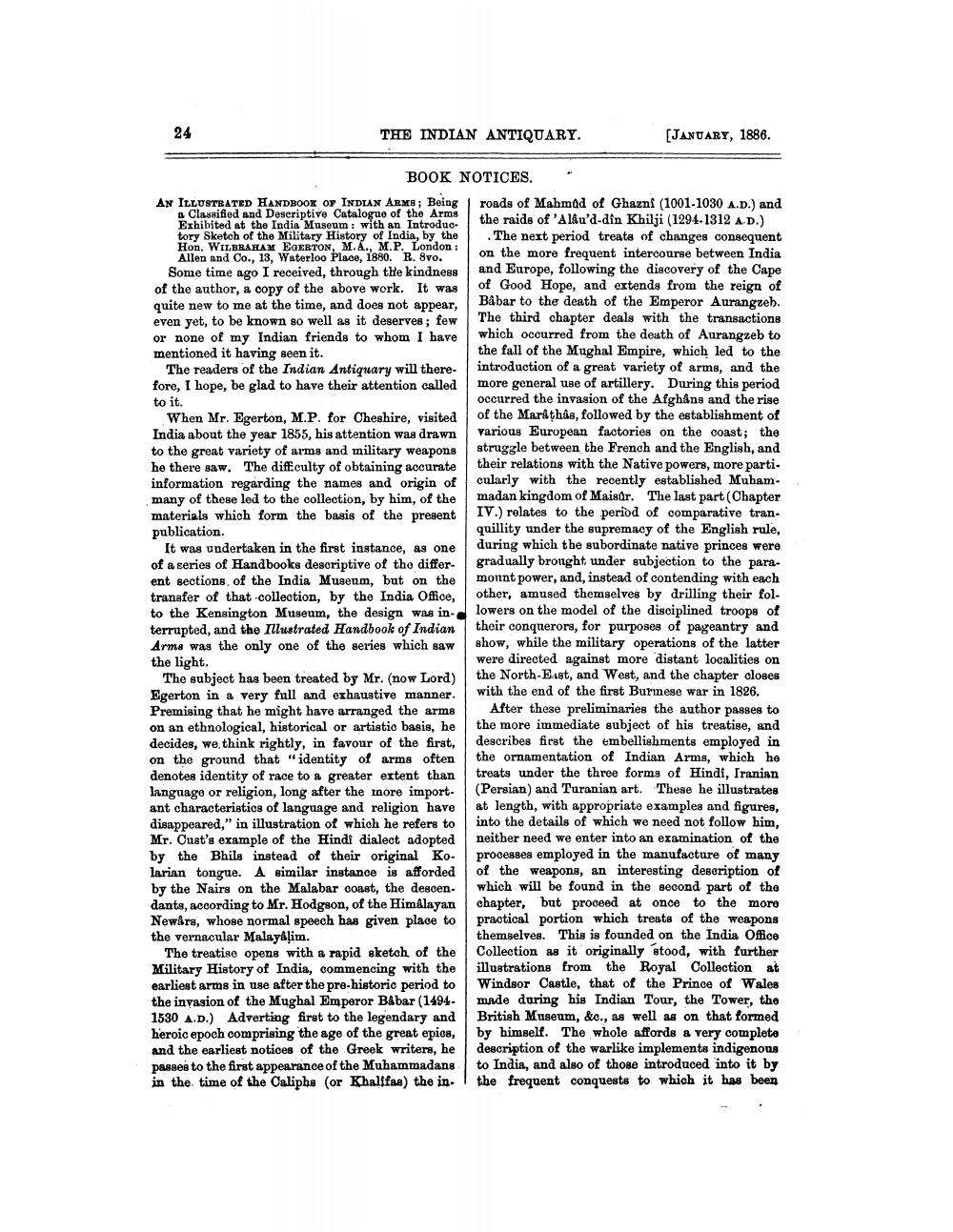________________
THE INDIAN ANTIQUARY.
[JANUARY, 1886.
BOOK NOTICES.
AN ILLUSTRATED HANDBOOK OF INDIAN ARMS; Being roads of Mahmod of Ghazni (1001.1030 A.D.) and
a Classified and Descriptive Catalogue of the Arms Exhibited at the India Museum : with an Introduc
the raids of 'Alau'd-din Khilji (1294.1312 AD.) tory Sketch of the Military History of India, by the The next period treats of changes consequent Hon. WILBRAHAM EGERTON, M.A., M.P. London: Allen and Co., 13, Waterloo Place, 1880. R. 8vo.
on the more frequent intercourse between India Some time ago I received, through the kindness
and Europe, following the discovery of the Cape of the author, a copy of the above work. It was
of Good Hope, and extends from the reign of quite new to me at the time, and does not appear,
Babar to the death of the Emperor Aurangzeb. even yet, to be known so well as it deserves; few The third chapter deals with the transactions or none of my Indian friends to whom I have which occurred from the death of Aurangzeb to mentioned it having been it.
the fall of the Mughal Empire, which led to the The readers of the Indian Antiquary will there- introduction of a great variety of arms, and the fore, I hope, be glad to have their attention called
more general use of artillery. During this period to it.
occurred the invasion of the Afghans and the rise When Mr. Egerton, M.P. for Cheshire, visited of the Markthâs, followed by the establishment of India about the year 1855, his attention was drawn
various European factories on the coast; the to the great variety of arms and military weapons struggle between the French and the English, and he there saw. The diffculty of obtaining accurate
their relations with the Native powers, more parti. information regarding the names and origin of
cularly with the recently established Muham. many of these led to the collection, by him, of the madan kingdom of Maisar. The last part (Chapter materials which form the basis of the present
IV.) relates to the period of comparative tranpublication.
quillity under the supremacy of the English rule, It was undertaken in the first instance, as one
during which the subordinate native princes were of a series of Handbooks descriptive of the differ- gradually bronght under subjection to the para. ent sections of the India Museum, but on the mount power, and, instead of contending with each transfer of that.collection, by the India Office, other, amused themselves by drilling their fol. to the Kensington Museum, the design was in lowers on the model of the disciplined troops of terrupted, and the Illustrated Handbook of Indian their conquerors, for purposes of pageantry and Arms was the only one of the series which saw show, while the military operations of the latter the light.
were directed against more distant localities on The subject has been treated by Mr. (now Lord) the North-Eust, and West, and the chapter closes Egerton in a very full and exhaustive manner. with the end of the first Burmese war in 1826. Pramining that he might have arranged the arms After these preliminaries the author pages to on an ethnological, historical or artistic basis, he the more immediate subject of his treatise, and decides, we think rightly, in favour of the first, describes first the embellishments employed in on the ground that "identity of arms often the ornamentation of Indian Arms, which ho denotes identity of race to greater extent than treats under the three forms of Hindi, Iranian language or religion, long after the more import. (Persian) and Turanian art. These be illustrates ant characteristics of language and religion have at length, with appropriate examples and figures, disappeared," in illustration of which he refers to into the details of which we need not follow him, Mr. Ouat's example of the Hindi dialect adopted neither need we enter into an examination of the by the Bhils instead of their original Ko- processes employed in the manufacture of many larian tongue. A similar instance is afforded of the weapons, an interesting description of by the Nairs on the Malabar coast, the descen- which will be found in the second part of the dants, according to Mr. Hodgson, of the Himálayan chapter, but proceed at once to the more Newars, whose normal speech has given place to practical portion which treats of the weapons the vernacular Malay&ļim.
themselves. This is founded on the India Office The treatise opens with a rapid sketch of the Collection as it originally stood, with further Military History of India, commencing with the illustrations from the Royal Collection at earliest arms in use after the pre-historic period to Windsor Castle, that of the Prince of Wales the invasion of the Mughal Emperor B&bar (1494- made during his Indian Tour, the Tower, the 1530 A.D.) Adverting first to the legendary and British Museum, &c., as well as on that formed heroic epoch comprising the age of the great epios, by himself. The whole affords a very completo and the earliest notices of the Greek writers, he description of the warlike implements indigenous passes to the first appearance of the Muhammadans to India, and also of those introduced into it by in the time of the Caliphs (or Khalffas) the in. I the frequent conquests to which it has been




